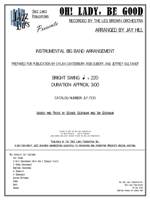OH! LADY, BE GOOD
Recorded by the Les Brown Orchestra
Arranged by Jay Hill, Prepared for Publication by Dylan Canterbury, Rob DuBoff, and Jeffrey Sultanof

Cat #: JLP-7135
$65.00This item usually ships within 1 business day.
Questions?
Please call +1-518-587-1102 or email us.
Audio Sample:
Edition: Jazz Big Band Arrangement
Description: Swing - Medium Difficult
Publisher: Jazz Lines Publications
Les Brown and his Band of Renown was arguably the most popular dance band in the country in the 1950s. Their takes on standards, although a bit formulaic, were often quintessential examples of the updated sounds of the big band era that started to re-emerge in the post-World War II years, and this Jay Hill arrangement of the Brothers Gershwin's "Oh! Lady Be Good" is no exception.
The melody is set up by an introduction that features a descending trumpet line followed by a simple sax riff. This intro largely sets the tone for the rest of the arrangement's construction. The trumpet section continues to be featured at the melody's introduction proper at measure 9. The trumpeters are paired off during this portion, with two players using cup mutes and the other two using Harmon mutes, so be cautious to maintain a good volume balance. The other horns provide backgrounds that are mostly limited to short riffs or counter lines to fill in the gaps in the melody. The trumpets yield the final A section to the saxes at measure 33, which features an extended harmonically altered tag to set up a chorus of trumpet solo at measure 45.
Following said trumpet solo, the band trades miniaturized shout choruses back and forth with a tenor sax solo beginning at measure 71. The real creativity of this portion of the arrangement comes from the multiple key signature changes, so make sure your ensemble keeps an eye out for them. The band eventually returns to the home key of G major for the final shout chorus at measure 103. Although the rhythms and registers are not particularly demanding during this section, there should be a continuous sense of building all the way through to the final A section at measure 121. At this point, the band should be roaring at full strength. The introduction is re-used (in slightly extended form) as an ending, with the addition of a final brass honk that gives way to a mellow sax chord for a conclusion.
This publication has been prepared from the original set of parts used during the recording session - this is not transcription.
2 Alto Saxophones (Alto Sax 1 Doubles on Flute)
2 Tenor Saxophones
Baritone Saxophone
4 Trumpets
3 Trombones
Guitar (Optional)
Piano
Bass
Drums
Trombone 1: C5







